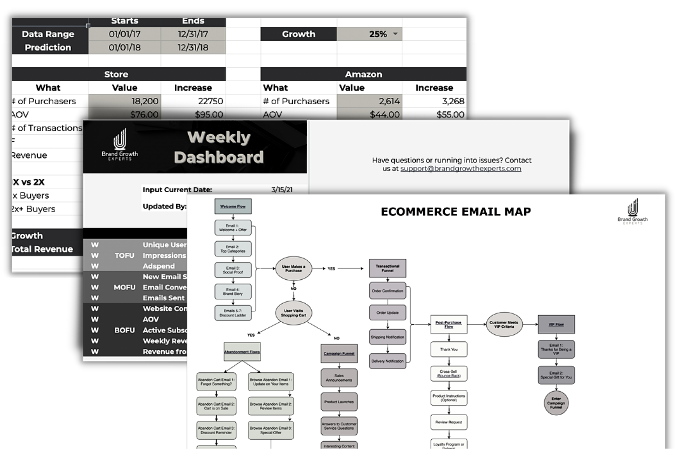141: What it takes to build & scale a $100M lifestyle brand with Jake Kassan
Do you want to know what it really takes to build a $100 million business and brand? Then this episode is for you.
Posted by: Austin Brawner on May 03, 2018
The quote: “If you don’t know where you are going, you’ll end up someplace else.”
Yogi, I couldn’t have said it better myself.
In Google Analytics we have so much access to data that most of us often feel overwhelmed by the data. And when we feel overwhelmed by the data we are rarely able to find any actionable insights to guide us into taking actions that will have a bottom-line impact on the business.
And this all stems from not choosing the right analytics key performance indicators (KPI’s) for our ecommerce site.
“Wow, we had 18,429 pageviews last month. An increase of 10% from the month before.”
“Cool, that’s great! But does the increase in pageviews mean people loved our site and read more content? Or does the increase mean visitors are having a hard time finding what they’re looking for?”
“Good question”
“Soooo…what do we do next?”
“Not sure, really, I just thought it was cool to know that people were checking out more pages, but now I don’t know if it’s all that cool.”
If you’re not choosing the right key performance indicators (KPI) to measure then, just like Yogi Berra so eloquently stated, your store will end up somewhere else… probably somewhere you don’t want to be.
Choosing the right KPI’s will give us direction, actionable insights, and bottom-line impact.
Here’s a definition we use for the term key performance indicator, one we received from our work with the number one analytics authority, Avinash Kaushik:
“Measures that help you understand how you are doing against your objectives.”
KPI’s are metrics. But for ecommerce analytics (or any serious business, not just ecommerce), KPI’s are not just ordinary metrics. KPI’s for us are metrics that have attained “extraordinary” status in our ecommerce business.
Meaning, they’re the ones that do the most work, that we pay the most attention to, that expose the most information about our business.
In the definition above, there is an emphasis on both ‘measures’ and ‘objectives’. If the metric does not help us understand how we’re doing against our business objective then it is not a KPI.
Hopefully, by now you’ve created your Digital Marketing & Measurement Model, or DM3 for short, so you should already know what your objectives are and the goals that belong to each objective.
Before picking the right KPI’s for your site, here are a few simple rules to follow that will guide you in your selection.
1) Start with Outcomes. Nothing matters more than the end result.
2) Make them simple and make them direct.
3) Make sure they measure success and failure in areas where you spend the most money.
4) Make sure they focus on pan-session analysis, i.e. what happens across multiple visits by the same person.
5) You must be able to segment them, e.g. conversion rate can be segmented to email conversion rate. DO NOT focus on averages.
6) Include the voice of the customer. Use a survey program to measure something like ‘Task Completion Rate’.
7) Choose something that helps you measure how you compare to your competitor.
Most ecommerce companies are turning some metrics into bad key performance indicators when measuring the success of their business.
Here are some examples of bad KPI’s:
1) # of Visits
2) # of Page Views
3) # of Emails Sent
4) # of Twitter Followers
5) # of Facebook Fans
6) Time on Site
7) Average Bounce Rate
8) Revenue (Yes, even revenue can be a bad KPI at times)
Sure, you can monitor these data points, but they shouldn’t be a key performance indicator in your DM3.
Why?
Well….
1) There is very little we can learn about these metrics that impact the bottom-line.
“Sweet, we had a 10% increase in visits, which lead to 3,000 more pageviews. We also sent 657 total emails, the average bounce rate went down to 16%, and time on site increased to 2:54.”
What does all of that actually tell us? Not much.
2) Most of these metrics are actions taken by visitors at the top of the funnel. Getting people to show up to our site, check out a few pages, and stay a bit longer on our site are not end goals. As an ecommerce storeowner, we want them to submit their email, purchase from our well-crafted marketing emails, buy our up-sells, share their experience with friends, and return to our site and repeat.
Worry about the outcomes, not top-of-funnel activity.
3) With these types of KPI’s we make a false assumption that more is better, or that more means we’ve succeeded. And the only thing assuming does is make an ‘A** out of U and ME.’
Remember the pageviews example at the top of the post? Well, how do we know if the increase in page views, and resulting increased time on site, is from increased visitor engagement with the content or if it’s from the visitor’s inability to quickly and easily find the information they’re desperately seeking?
More does not equal better.
I’m sure you’re starting to wonder, “so what, then, are examples of some great key performance indicators?”
Great question!
Read part two of this two-part post to find out.
If you need some help figuring out your KPI’s, feel free to email me at Chad@EcommerceInfluence.com and we can schedule a 115-minute chart to give you some direction.
Your turn (Leave your comments below): What other rules do you have to help you determined the best KPI’s for your site?

Enter your email to get our proven resources that will help you achieve massive growth without the burnout.